Six Reasons Not to Buy SIOS High Availability Software . . . If You Dare
Six Reasons Not to Buy SIOS High Availability Software . . . If You Dare
You need SIOS Protection Suite (for Linux or Windows) or SIOS DataKeeper Cluster Edition for high availability protection for business critical applications.
UNLESS
1. You prefer free solutions only.
I get it. There are definitely times when I do the same thing when I need to learn a new skill, get a quick tip, drop a few pounds, or set up a quick demo. Rather than signing up for a subscription, purchasing a license, or investing in a combination of the two, I have gone the free route.
However, the saying often holds true, you get what you pay for. Free trials are fine. Permanently free high availability is like gas station sushi – is the risk really worth it? Be sure that free doesn’t prevent you from utilizing the fullness available for optimizing uptime and increasing availability. Make sure you aren’t passing over a reasonably priced high availability solution that is proven to protect your mission-critical applications.
2. Being a single solution shop solution is more important than meeting your HA needs.
We were a “Ford tough” family for decades. Seriously. I understand what it is like to be a one solution shop. My dad owned a Ford truck for work, a Ford Mustang for leisure, a Ford 3600 tractor for the farm, and a Ford minivan for family travel. There was even a season where we received model toy cars with the brandished blue oval as well.
But, when my wife and I were branching out on our own family needs, we broke away from the single solution to address needs that fell out of the Ford wheelhouse (at the time). You may be a single shop buyer, but if your needs have changed and the HA provider or solution hasn’t kept up, consider whether expanding the solution set will eliminate risks, improve success, or be worth the investment in a complementary solution for those new needs. When we needed a reliable, gas efficient, sleek, family friendly, and economical solution for our family, we supplemented Ford tough with a Honda Odyssey. If you are a single stop shop, and you are not worried about vendor lock-in best of luck.
3. You are more of a do it yourself-er coder.
You like coding. You like to write a lot of scripts, and don’t mind pulling out your bash, ksh, perl, python, powershell, batch or command tool kit and wiring things up yourself. You value the joy in flexibility and adding your own tweaks.
I love writing code as well, but there are times when the last thing I want to do is spend time writing a lot of code and scripts for a problem that is solved, proven, and off the shelf ready. For the do-it-yourself admin, off-the-shelf may not be your preference, but consider whether 20 years of expertise and experience should be rehashed and re-architected for your enterprise. But, if you have to get the code writing fix in, High Availability Software SIOS provides the Generic Application Recovery Kit for you to get in a coding fix.
4. You need Ubuntu support (or Solaris).
Your environment is unique. You have customers who’ve cut their teeth on Solaris and are hanging on to it for dear life. Or you’ve got those who have fully embraced the Linux realm and have moved to Ubuntu. In either case, you look at the SIOS products matrix and Ubuntu isn’t currently a match for your SIOS version. Bummer!
While this is true, consider the rich and vast features and flavors of support that are still available. While there are parts of your enterprise that have dug in on Solaris and others that have raced to embrace Ubuntu and newer variants of Linux, it is more likely that you need a solution capable of supporting RHEL, OEL, SuSE, CentOS and possibly Windows as well. Be sure not to single out a high availability solution by what it doesn’t provide and consider the depth of what it does.
5. You don’t run a hybrid of anything in your environment.
I heard it in the middle of a movie last week. The lead character commented on the idea of moving forward with some new idea of an overly excited owner. The classic line: “Sometimes the juice isn’t worth the squeeze.” In your mind you feel that you aren’t running a hybrid environment. Your applications are critical, but not complex. The moving parts are simple- a database, front end and a supporting application. It makes sense that you might not want to “complicate” things with additional processes, products, solutions or services, and you may feel like the juice isn’t worth the squeeze.
Before you make that final decision for a High Availability Software, assess whether a non-hybrid environment is the same as a simple environment. Consider whether or not the moving parts are as simple as you imagine or whether a solution with failover orchestration would be beneficial to reducing your overall RTO and increasing your RPO.
6. Endorsements from HA experts and experience don’t matter.
I bought a set of headphones online in mid-April. As I suspected, I discovered that anyone can do bluetooth headphones. But, not everyone can do them well. Ergonomically, the “new to market” headphones are a nightmare. Pairing was a breeze, but accidental unpairing is a constant battle. The sound quality is amazing, but that amplifies my annoyance when the headphones randomly chirp – loudly and clearly – for system sounds or at the end of a song.
You may believe that high availability and application monitoring can be done by anyone and that experience doesn’t matter. However, consider your own experiences and mine and ask if you’d really want to trust your enterprise environment to a group that just started thinking about the complexities of hybrid environments, or the dependencies and application-centric knowledge needed for the applications you use most frequently.
When deciding the right High Availability Software for your environment, consider carefully whether you want to go without the many best in class features, hardened and tested solutions, knowledgeable experts, broad swath of supported applications and environments, and industry leading experience and decades of insight. Then after careful consideration, choose wisely.
-Cassius Rhue, Vice President, Customer Experience, SIOS
Reproduced with permission from SIOS


